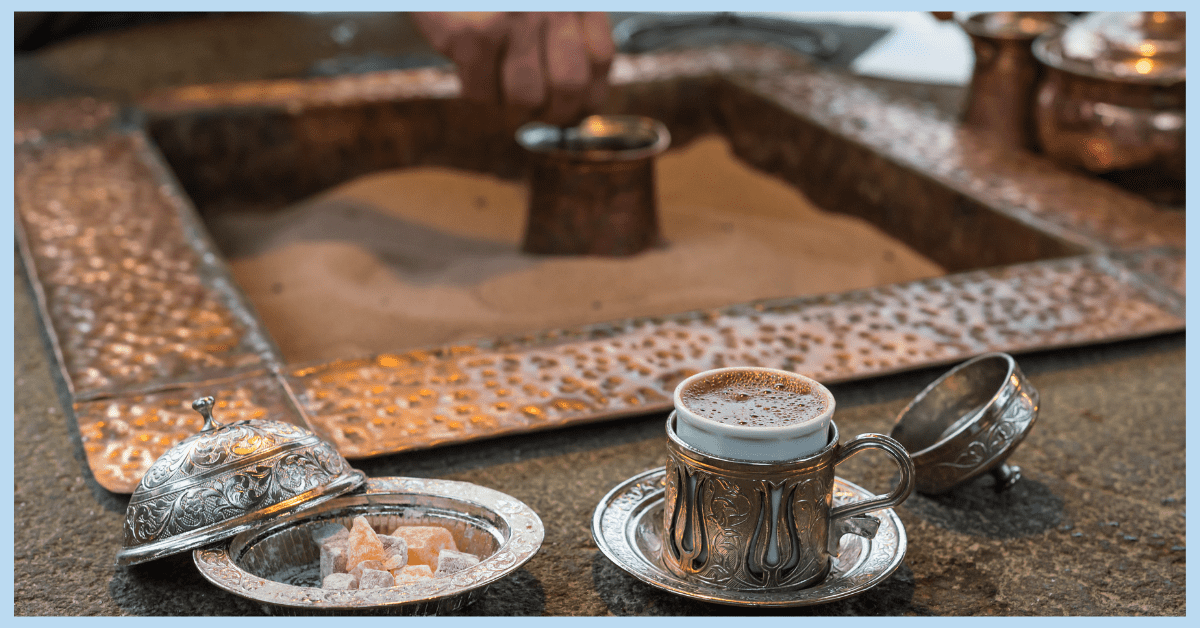Whether you saw a viral video, heard someone mention it at a party, or witnessed it firsthand, you might’ve recently come across the fact that Turkish Coffee is authentically prepared in hot sand.
Over centuries, cultural traditions tend to get lost and replaced with easier or more efficient methods of doing things. But because Turkish Coffee is so deeply ingrained in modern Turkish culture, it’s important to understand its roots. And, hopefully, keep them alive.
A brief history of Turkish Sand Coffee
Turkish Coffee has a long, complex history, but it’s not entirely clear at the earliest stages.
Coffee reached the Ottoman Empire around the late 15th century or early 16th century – well before finding its way across Europe and eventually the world.
It’s hard to establish exactly where the concept of using sand to prepare the coffee originated, but scholars believe it was used in several cultures inside the Ottoman Empire.
For a long time in Turkey, coffee was strictly prohibited. Political and religious leaders claimed coffee was leading to the spread of false political rumors and stealing time away from praying. At one point, it was considered worse than alcohol. The penalty was severe – death.
Luckily, as coffee became more popular in Turkey, the laws changed. Phew!
After it became more accepted, sultans and nobles started having their workers prepare it using the hot sand method. The method allows for a more consistent and thorough heat than the flames of a fire to produce a creamy smooth consistency.
Now, Turkish Coffee is a vital part of Turkish culture. You couldn’t go to Turkey and NOT have a cup of Turkish Coffee, at least to try. People even used to have fun with the remaining coffee at the bottom of a cup. Historically, the grinds left in the bottom of cups were sometimes used to tell fortunes, in much the same way tea leaves have been used in other cultures. Friends still do it for each other today!
Turkish Coffee is also involved when two people want to get married! It’s customary for the future groom to bring his family to visit the future bride’s family and ask for their blessing. During this visit, the future bride will serve everyone Turkish Coffees and, as a joke, she might add salt instead of sugar to her groom’s coffee. He can’t complain because it’d be extremely rude, so he just has to pretend it’s sugar and that can help show he’s a good guy.
There’s even a Turkish saying, “The memory of a cup of coffee lasts for forty years”.
While this is more referring to the events that happen around a cup of coffee, it shows just how valued the experience and tradition of Turkish Coffee really is.
Also, in 2013, Turkish Coffee culture and tradition were added to UNESCO’s Representative List of the Intangible Cultural Heritage of Humanity on behalf of Turkey.
Is Turkish Sand Coffee the same as regular Turkish Coffee?
Not quite. While the coffee itself is the same, because the methods of preparation are different, they produce different aromas, tastes, and consistencies.
Many will try and claim their coffee is authentic Turkish Coffee, despite not using traditional preparation methods.
But these days, Turkish Coffee is not commonly made in sand anymore. As such, don’t feel that you aren’t getting real Turkish Coffee just because it wasn’t made in sand!
A main aspect that makes Turkish Coffee special is how aromatic and strong it is. A good cup will be velvety, full of froth, and hot.
The most distinctive part of making Turkish Coffee is not filtering out the beans. Instead, they are ground up into extremely fine particles, and left in the water to be drunk. The water gets so thick that a layer of the fine coffee particles accumulate at the bottom of a cup. You don’t drink that bit!
Most of the time, you’ll want to use Turkish Coffee grounds – arabica varieties are preferred – but blends are sometimes used as well. You can purchase these already ground, but as always: the fresher, the better! Try the best (in my opinion!) Turkish Coffee brand here (from Amazon).
Whether it’s made in sand, over fire, or on stovetop, the water and coffee beans are brought to a boil in a cezve (otherwise known as ibrik). Get your own cezve here (from Amazon). This is a small, long-handled pot traditionally crafted from copper or brass.
A study actually found that using a copper pot in the sand had a slightly better aroma and a more roasted flavor. However, there are less antioxidants in the drink with this method, as the heat breaks them down.
Is the sand method better than stovetop?
To be completely honest, it’s very subjective! If you prefer a more authentic experience, then I’d say Turkish Coffee made with the sand method would be better. But if you’re just looking for a solid straightforward cup, stovetop is delicious too.
If you’re visiting Turkey and have the option, I’d hands down 100% recommend trying both methods and seeing which one you prefer! Most cafés and coffeehouses don’t serve it the sand method way because it’s not very efficient, so you’ll have to walk around to find a street vendor or stall that sells it.
How Turkish Sand Coffee Works
The sand used for making Turkish Coffee can be prepared in a variety of ways, but it’s now most commonly heated in a pan over a stove.
Once it’s scorching, the cezve is put into the sand. Done correctly, it’ll be ready quickly because of the high heat! While it might not look like it’s boiling and hot, I promise the sand is super hot and heats the coffee very well. The cezve is taken off and put back on the sand a few times to really make sure it’s thick and frothy.
What kind of sand is used?
A fine silica sand is best, as it transfers the heat most evenly.
A ‘clean’ sand that’s free from impurities is always preferred, as there may otherwise be an unpleasant smell when it’s heated. This is why I don’t recommend filling a bucket at the local beach! Make sure it’s heat and fire proof, too.
Can I make Turkish Sand Coffee at home?
Yep, you definitely can!
First, you’ll need some finely grounded Turkish Coffee. Regular coffee grinds will be too coarse, so very finely grounded arabica coffee is the way to go. You can find it at your local Turkish supermarket or buy the best (in my opinion!) Turkish Coffee here (from Amazon).
Otherwise, if you have a coffee grinder at home, you can technically grind regular coffee beans yourself. However, you’ll need a grinder capable of making the grinds extremely fine to do this properly.
Now, for the water. It might seem obvious to just go to the tap, but for this type of coffee, you’re going to want to use filtered water so the coffee is free from chemicals found in tap water.
Following that, fill a pan with the sand and heat it on your stovetop. Get that sand scorching hot!
Meanwhile, place your Turkish Coffee powder, filtered water, and a bit of sugar in the cezve. Get your own cezve here (from Amazon). You’ll want about 1.5 cups of water per cup of coffee. As for sugar, that’ll be trial and error based on your preferences.
When the sand is ready, carefully place the cezve into the sand. Then stir.
Wait until the water starts to boil, which will depend on how hot the sand was able to get.
As soon as it rises to the rim, pick it up, let it settle, and then repeat until you’re happy with the level of froth. It should be pretty frothy so that froth transfers over to each cup you pour out.
Pour the coffee into your cups and make sure to spoon the froth on top of each, covering the top of each top with a thin layer of froth.
You can use this exact same method without sand as well. Just place the cezve directly on top of the stovetop. Easy!
Traditionally, Turkish Coffee is served in a small porcelain cup (called a kahve fincanı in Turkish) beside a small cup of water and a piece of Turkish Delight for after you’re done drinking.
The cup of water and Turkish Delight are meant to first cleanse and then sweeten your palate after drinking a cup of Turkish Coffee, especially if you didn’t add sugar to it. In Turkey and Turkish restaurants, you’ll see Turkish Coffee is almost always served this way.
While Turkish Coffee was once made exclusively with sand, it’s certainly not required for a delicious, authentic cup!
More important is the type of beans you use, the technique of not filtering those beans, and the pot that it’s heated in.
Next time you’re in Turkey, be sure to order a Turkish Coffee to experience the uniqueness of this drink that’s been enjoyed for over 500 years!

